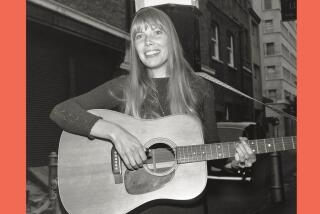Book Reviews : Streisand: Enigma Wrapped in Mystery
- Share via
Barbra Streisand: The Woman, the Myth, the Music by Shaun Considine (Delacorte Press: $17.95)
This compact and complex journalistic tour de force is based equally on two strong traditions of English and American literature; one new, one old. The more recent was begun by Gay Talese, who, sent out by Esquire to profile Frank Sinatra and denied even one interview, became enraged. Talese followed Sinatra for days, interviewed everyone around him, came up with the brilliant and lengthy “Frank Sinatra Has a Cold,” thus inventing what we still call “the New Journalism,” although it’s decades old.
The second tradition precedes all that by 400 years or so. In England--after Chaucer but before Shakespeare--a group of poets, including Thomas Sackville, Earl of Dorset, worked together under the leadership of William Baldwin on a long poem called “A Mirror for Magistrates,” which attempted “to tell in verse the stories of English kings or prominent noblemen and courtiers who had suffered tragic falls from high estate.” “A Mirror for Magistrates” was an enormous success, and a great reassurance to the common reader. It called upon ideas of the Wheel of Fortune and the concept of hubris or overweening pride: Strive to go too high and your bad deeds shall find you out, or, the higher you go the harder you fall. It was the English equivalent of what some enlightened California teen-agers now call “Karm-uppance.”
Using, then, the very strictest journalistic rules, Shaun Considine approaches his material: the life of Barbra Streisand. Evidently he couldn’t get (or didn’t want?) the cooperation of her mother or other miscellaneous relatives, for Barbra springs into life like an air plant; already at 18, what she is: a performer bound to succeed, 18 years old in 1960, singing in a gay bar in Greenwich Village, dressing in thrift shop scraps, living in an apartment that smells of fish. At the bottom of the Wheel of Fortune, but heavily supplied with hubris, or in this case, chutzpah .
The author, denied--over a period of 15 months--even one interview from Streisand, relies, he tells us, on more than 125 hours of other interviews with more than 200 people, on his own copious research, and his first-person experiences. It’s not true to say he shows no editorial bias; that would be impossible in a work like this. It becomes obvious in this dense narrative of American success and weirdness that Considine considers Streisand’s first husband, Elliott Gould, a good sort, and her later consort, hairdresser- cum- producer Jon Peters, as kissing cousin to a reptile, but about Barbra herself he reserves editorial comment. And lets the reader come to his or her conclusion.
What there was (and is) to Streisand is a phenomenal voice, a voice that moved people to tears, that brought others to happiness--peaks they might never experience again. One person in this narrative remembers driving along the Pacific Coast Highway with Streisand beside him in the passenger seat--the sun shining, and Streisand’s son eating a Bit o’ Honey candy bar. Why not just drive over a cliff and end it all? he thought. Because he knew in all his life there’d never be anything like this--in joy and intensity again.
But behind the voice, and the owner of the voice, and the working personality who, though a perfectionist, was often pleasant to work with, there was a woman who began--quite soon--to evolve, according to these accounts, at least--into something you’d see in a low-budget Japanese horror movie, flapping creakily around the sky, opening its jaws to gobble up whole towns. A really scary lady.
When she was still only 20 and appearing in New York in “I Can Get It for You Wholesale,” and learned on a particular night that her understudy, Elly Stone, had a concert scheduled, Streisand called in sick: “All day we got reports from Elliott about her health. I was a wreck. The concert was very important to me, but if I didn’t understudy for Barbra I would be kicked out of Equity. At the half hour we found out she was OK. She came to the theater and we learned it was all a joke. She was never sick. This was one of her little games, and Elliott was a co-conspirator. Years afterward he apologized. . . .”
Barbra Streisand hated the Beatles, snubbed Princess Margaret, and when she met Muhammad Ali, who had just won the heavyweight championship of the world, in the halls of Columbia Records, Dave Kapralik, an employee there, recalls: “He was Cassius Clay then . . . he had an album entitled ‘I Am the Greatest’ on Columbia, so I introduced them. But Barbra pretended not to know who he was. ‘I am the Greatest,’ he told her. ‘The greatest what?’ she replied, and walked away.”
A horrible fascination comes over the reader somewhere around Page 20 and doesn’t lift until the end. The fascination comes certainly from one’s own childhood, when you see one of your peers getting away with murder. (I saw it myself at a children’s school play, when Streisand came with an entourage, sat in the dead center of an audience, stayed through the first act, came back after intermission and left, in a great clatter of folding chairs, as the 12-year-olds acted their hearts out to an audience with a huge empty hole in it, and had to save their tears for later.)
There is so much information here that the book functions on several levels: As a manual about American music business, journalism, movies, and business, period, this volume is brilliant. “Streisand” is excellent, clean, well-researched, dazzling.
But for the reader who keeps waiting for the celestial ax to fall on the girl who was mean to Muhammad Ali, Considine reveals, in an aesthetically satisfactory manner, why she was denied even an Oscar nomination for “Yentl.” This is a fierce “Mirror for Pop Stars.”
More to Read
Sign up for our Book Club newsletter
Get the latest news, events and more from the Los Angeles Times Book Club, and help us get L.A. reading and talking.
You may occasionally receive promotional content from the Los Angeles Times.







